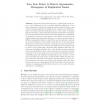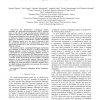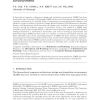536 search results - page 96 / 108 » Reusing Models of Different Abstraction Levels |
ATAL
2010
Springer
13 years 10 months ago
2010
Springer
Learning, planning, and representing knowledge in large state t multiple levels of temporal abstraction are key, long-standing challenges for building flexible autonomous agents. ...
RECOMB
2005
Springer
14 years 10 months ago
2005
Springer
Abstract. Asymmetric functional divergence of paralogues is a key aspect of the traditional model of evolution following duplication. If one gene continues to perform the ancestral...
JCC
2007
13 years 9 months ago
2007
Abstract: A hybrid quantum mechanical/molecular mechanical (QM/MM) potential energy function with HartreeFock, density functional theory (DFT), and post-HF (RIMP2, MP2, CCSD) capab...
KBSE
2009
IEEE
14 years 4 months ago
2009
IEEE
—In the Model-Driven Architecture (MDA) paradigm the Query/View/Transformation (QVT) standard plays a vital role for model transformations. Especially the high-level declarative ...
TOMACS
1998
13 years 9 months ago
1998
architectures at multiple levels of abstraction, encompassing both hardware and software. It has five modes of operation (Design, Model Validation, Build Simulation, Simulate Syste...



